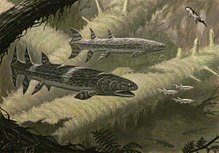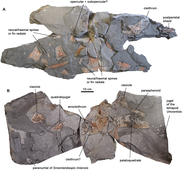Hyneria
| Hyneria Temporal range:
| |
|---|---|

| |
| Life restoration of H. lindae | |

| |
| Skull reconstruction of H. uldezinye | |
| Scientific classification | |
| Domain: | Eukaryota |
| Kingdom: | Animalia |
| Phylum: | Chordata |
| Clade: | Sarcopterygii |
| Clade: | Tetrapodomorpha |
| Clade: | Eotetrapodiformes |
| Family: | †Tristichopteridae |
| Genus: | †Hyneria Thomson, 1968 |
| Type species | |
| †Hyneria lindae Thomson, 1968
| |
| Other species | |
| |
Hyneria is a genus of large prehistoric predatory lobe-finned fish which lived in freshwater during the Devonian period (Famennian).[1][2]
Etymology
The genus name Hyneria is a reference to the village of Hyner, Pennsylvania, near where the first specimen was found. The species epiphet H. lindae is derived from the name of the wife of Keith Stewart Thomson, who described this fish.[3]
Description
Hyneria was a large fish. H. lindae is estimated around 2.5–3 metres (8.2–9.8 ft) in total length.[3][4] The largest complete jaw reaches 38 centimetres (15 in), but there is much larger fragment possibly from a jaw about twice that length, although that specimen may belong to a rhizodont instead.[5] A second species, H. uldezinye, was once estimated at range between 2–4 metres (6.6–13.1 ft) before being described.[6] However, the species description estimates that the largest specimen belongs to an animal about 2.7 metres (8.9 ft).[2] Based on an unpublished specimen (it is not mentioned which species it belongs to), Hyneria was possibly able to reach up to 3.5 metres (11 ft) long.[7] Its skull had heavy, ornamented dermal bones and its lower jaw was relatively long and shallow. The teeth were stout, with those of the premaxilla forming fangs upwards of 5 cm (2 in).[3][1] Its body was covered by cycloid scales.[1][8] It had large sensory canals to aid in detection of possible prey, as the freshwater environment it inhabited likely was murky and had low visibility.[8] Adult individuals retained juvenile features (i.e. partially unossified skeletons), suggesting that they were likely neotenic.[9]
Discovery

The original fossils came from two localities in Pennsylvania, United States, one found between the villages of North Bend and Hyner and another near Emporium. They consisted of a disarticulated partial skull and fragments of the shoulder girdle.[3] The fossils were found in the Catskill Formation of the Red Hill Shale, dating to the upper Devonian.[1] These were the only remains known until 1993 when a renewed collecting effort discovered abundant new material.[1] Hyneria is considered the largest and most common lobe-finned fish found in the Red Hill Shale.[10] In February 2023 a second species of Hyneria, H. udlezinye, was named from remains discovered in the Waterloo Farm lagerstätte. These remains include the skull and shoulder girdle.[2]
References
- ^ a b c d e Daeschler, EB; Shubin, NH (2007). "New data on Hyneria lindae (Sarcopterygii, Tristichopteridae) from the Late Devonian of Pennsylvania, USA". Journal of Vertebrate Paleontology. 27 (S3). doi:10.1080/02724634.2007.10010458.
- ^ a b c Gess, Robert W.; Ahlberg, Per E. (2023-02-22). "A high latitude Gondwanan species of the Late Devonian tristichopterid Hyneria (Osteichthyes: Sarcopterygii)". PLOS ONE. 18 (2): e0281333. Bibcode:2023PLoSO..1881333G. doi:10.1371/journal.pone.0281333. ISSN 1932-6203. PMC 9946258. PMID 36812170.
- ^ a b c d Thomson, K. S. (1968). "A new Devonian fish (Crossopterygii: Rhipidistia) considered in relation to the origin of the Amphibia". Postilla. 124.
- ^ Daeschler, Edward B.; Downs, Jason P. (2018-05-04). "New description and diagnosis of Hyneria lindae (Sarcopterygii, Tristichopteridae) from the Upper Devonian Catskill Formation in Pennsylvania, U.S.A." Journal of Vertebrate Paleontology. 38 (3): e1448834. Bibcode:2018JVPal..38E8834D. doi:10.1080/02724634.2018.1448834. ISSN 0272-4634. S2CID 89661336.
- ^ Young, Ben; Dunstone, Robert L.; Senden, Timothy J.; Young, Gavin C. (2013-03-06). "A Gigantic Sarcopterygian (Tetrapodomorph Lobe-Finned Fish) from the Upper Devonian of Gondwana (Eden, New South Wales, Australia)". PLOS ONE. 8 (3): e53871. Bibcode:2013PLoSO...853871Y. doi:10.1371/journal.pone.0053871. ISSN 1932-6203. PMC 3590215. PMID 23483884.
- ^ Gess, R.W.; Whitfield, A.K. (2020). "Estuarine fish and tetrapod evolution: insights from a Late Devonian (Famennian) Gondwanan estuarine lake and a southern African Holocene equivalent". Biological Reviews. 95 (4): 865–888. doi:10.1111/brv.12590. PMID 32059074. S2CID 211122587.
- ^ Engelman, Russell K. (2023). "A Devonian Fish Tale: A New Method of Body Length Estimation Suggests Much Smaller Sizes for Dunkleosteus terrelli (Placodermi: Arthrodira)". Diversity. 15 (3). 318. doi:10.3390/d15030318.
- ^ a b "25 years of fossil collecting yields clearest picture of extinct 12-foot aquatic predator". ScienceDaily. 7 May 2018.
- ^ Kamska, V.; Daeschler, E.B.; Downs, J.P.; Ahlberg, P.E.; Tafforeau, P.; Sanchez, S. (2019). "Long-bone development and life-history traits of the Devonian tristichopterid Hyneria lindae". Earth and Environmental Science Transactions of the Royal Society of Edinburgh. 109 (1–2). Cambridge University Press: 75–86. doi:10.1017/S175569101800083X. ISSN 1755-6910. S2CID 134090370.
- ^ "The Missing Link". Nova. Season 29. Boston. February 26, 2002. PBS. Transcript: "The Missing Link".
External links
- Hyneria at Devonian Times






